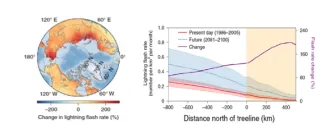Lightning is rare in the contemporary Arctic and is an indicator and a driver of climate change. Here, using satellite observations of lightning flash rate and climate reanalysis data, scientists find that the spatial pattern of summer lightning over northern circumpolar regions exhibits a strong positive relationship with the product of convective available potential energy and precipitation (Chen et al., 2021). Applying this relationship to CMIP5 climate projections for a high-emissions scenario (RCP8.5) shows an increase in convective available potential energy (86 ± 22%) and precipitation (17 ± 2%) in areas underlain by permafrost, causing summer lightning to increase by 112 ± 38% by the end of the 21st century. Future flash rates at the northern tree line are comparable to current levels 480 km to the south in boreal forests. They hypothesize that lightning increases may induce a fire–vegetation feedback whereby more burning in Arctic tundra expedites the northward migration of boreal trees, with the potential to accelerate the positive carbon-climate feedback associated with permafrost soil carbon release.
Citation: Chen, Y., D. M. Romps, J. T. Seeley, S. Veraverbeke, W. J. Riley, Z. A. Mekonnen, and J. T. Randerson. 2021. “Future lightning increases in the Arctic: implications for fire and permafrost carbon.” Nature Climate Change 11: 404–410. https://doi.org/10.1038/s41558-021-01011-y.


